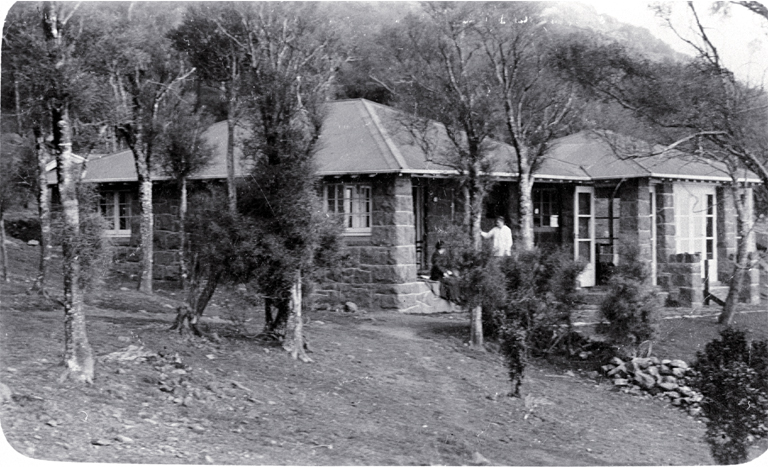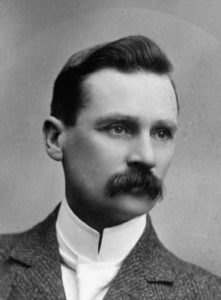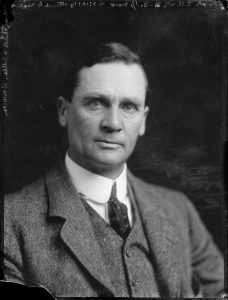Henry George Ell (1862-1934), commonly known as Harry Ell, was a Christchurch City Councillor and a New Zealand member of Parliment. He is famous for his conservation work around Christchurch’s Port Hills, his advocacy for the Summit Road, and his construction of the Sign of the Takahe and other road houses along the Summit Road.
Without Harry Ell's vision of a Summit Road the scenic reserves of the Port Hills would have been lost to Canterbury, and the extensive use made of the Port Hills by Christchurch people today (walking, jogging, mountain-biking) would not be possible.
Early life
Harry Ell was born in Christchurch probably on the 24th of September 1862. He grew up on a farm at Halswell and left school at the age of 15 to work firstly as a junior attendant at the Canterbury Museum, before being employed on a sheep station and then at a wool-scouring works.
From 1881 to 1884 he was a member of the Armed Constabulary in Taranaki, serving at Parihaka. He was later critical of the race policies of those years: [their] ‘actions had … brought about the bitterness and estrangement between the two races….’
When he returned to Christchurch he worked in a variety of jobs, including some years as a printer for the Christchurch Press. On 10 January 1892 Ell married Adelaide Eleanor Gee in Christchurch.
Involvement in politics
From 1884 Harry Ell had become interested in politics. He was at various times president of the Christchurch Tailoresses’ and Pressers’ Union and also a committee member of the Canterbury Children’s Aid Society, the Canterbury Prohibition Council and the Prohibition League.
In 1903, and from 1917 to 1919 he sat on the Christchurch City Council.
He stood for parliament unsuccessfully in 1896, then won the City of Christchurch seat in 1899 as an independent liberal. In 1905 with an electorate re-organisation he won the Christchurch South seat, and held it through until 1919, briefly serving as postmaster general in 1912. Harry had a strong interest in welfare and labour issues, and while in Parliament he supported moves to introduce the old age pension, and a range of educational changes such as physical education in schools and a school dental service.
An enthusiastic naturalist, he wanted to preserve forests to conserve soil and water, and create reserves and afforestation programmes to ensure adequate timber supplies and to provide better training for scientific foresters. His visionary campaign to develop reserves on a systematic basis during land settlement was influential in the passing of the Scenery Preservation Act.
He remained involved in local politics, and following his stint as a city councillor he stood for the Lyttelton electorate, which included the Port Hills. He was defeated and did not win a seat in Parliament again.
The Summit Road scheme
![Sign of the Kiwi, Port Hills, Christchurch, showing toll gates [ca. 1930]](https://christchurchcitylibraries.com/Heritage/Photos/Disc1/IMG0078.jpg)
The first scenic reserve was set up at Kennedy's Bush in 1906 with help from the government and public fund-raising. Three rest-houses were later built: the Sign of the Bellbird, the Sign of the Kiwi, and the Sign of the Packhorse.
By the 1930s there were a string of reserves, consisting of some 500 acres, along the proposed road line, which had been surveyed from Godley Head to the Pigeon Bay saddle, and large parts of the Port Hills section of the road had been built.
Harry Ell's last years were spent supervising the construction of the fourth rest-house, the Sign of the Takahe. Relief workers, known as Ell's Angels, and an expert carver, Mary Sophia Douglas, helped in this work. Ell died on 27 June 1934 in Christchurch.
The two-storeyed building of the Sign of the Takahe was not finally completed until 1949, 15 years after his death. All four houses were built of local stone, and designed to blend in with the landscape.

In 1923, Ell wrote of himself, ‘I will not yield up to the keeping of others, the ideals and sentiments which I have always associated with this public work... It is my work and I intend to continue with it’.
More resources
- Search our catalogue for resources about Harry Ell and the Summit Road.
- Digitised Harry Ell Papers (Canterbury Stories) - A selection from a collection of material covering the career and interests of Harry Ell. The collection includes letter books, scrapbooks, speeches, and photographs, 1890-1972.
- Browse our Sign of the Kiwi and Sign of the Takahe webpage.
- Digital NZ images of the Summit Road rest houses
- Ell, Henry George: Eric Pawson. 'Ell, Henry George', from the Dictionary of New Zealand Biography. Te Ara - the Encyclopedia of New Zealand, updated 7 June 2013.
- Bateman New Zealand encyclopedia, 5th edition. Auckland, 2000
- Dictionary of New Zealand biography, Vol. 2, 1870-1900; Vol. 3, 1901-1920. Wellington, 1990-2000
- Death of Mr H.G. Ell Press, Volume LXX, Issue 21202, 28 June 1934, Page 10
- Ministers pay tribute Press, Volume LXX, Issue 21202, 28 June 1934, Page 10
- Suspicious fire at Sign of the Bellbird Press, 7 September 2015


